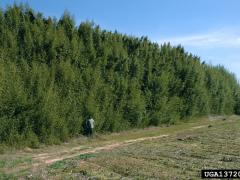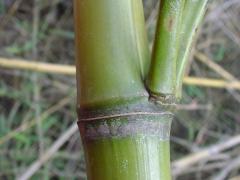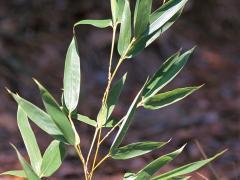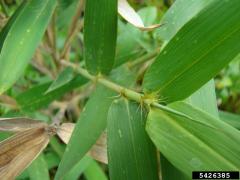Invasive Species: Phyllostachys aurea, Golden Bamboo
Golden bamboo is an invasive perennial, reedlike plant that can reach heights of 16 to 40 ft. (5 to 12 m). The canes (stems) are hollow with solid joints and can be 1 to 6 in. (2.5 to 15.2 cm) in diameter. Leaves are alternate, 3 to 10 in. (7.6 to 25.4 cm) long, and 0.25 to 0.75 in. (0.6 to 1.9 cm) wide. Flowering is rare (occurring maybe once every 7 to 12 years). Plants spread by rhizomes. Infestations are commonly found around old homesites and can rapidly expand in size. Golden bamboo can form dense, monocultural thickets that displace native species. Once golden bamboo is established, it is difficult to remove. Golden bamboo is native to China and was introduced in the United States in 1882 for ornamental purposes.
What are invasive species, and why should we be concerned about them?
Taxonomy: Scientific and Common Names for This Species
Cyperales > Poaceae > Phyllostachys aurea Carr. ex A.& C. Rivière
Phyllostachys aurea – USDA PLANTS Profile
Distribution Maps
golden bamboo – The reported distribution of this invasive species across the United States (Source: Invasive Plant Atlas of the United States)
Up-to-the-minute distribution maps and why they are important
Reporting This Invasive Species
What is the best way to report the occurrence of an invasive species?
How to report an invasive species sighting to EDDMapS – Early Detection & Distribution Mapping System
EDDMapS – Report an invasive species to EDDMapS.
County Extension Offices – Find your county Extension office on this map provided by USDA.
How to Identify
This invasive species can be identified by looking for the characteristics described in the paragraphs that follow.
Grass
Golden bamboo is a perennial, reedlike plant that can reach heights of 16 to 40 ft. (5 to 12 m).
 |
 |
| David J. Moorhead, University of Georgia, bugwood.org | Chuck Bargeron, University of Georgia, bugwood.org |
Foliage
Leaves are alternate, 3 to 10 in. (7.6 to 25.4 cm) long, and 0.25 to 0.75 in. (0.6 to 1.9 cm) wide.
 |
 |
| James H. Miller, USDA Forest Service, bugwood.org | James H. Miller, USDA Forest Service, bugwood.org |
Flower
Bamboo rarely if ever flowers in the United States.
| bugwood.org | bugwood.org |
Fruit
Clones are generally used in cultivation, so fruit is rarely produced. Bamboo escapes and spreads from rhizomes.
 |
|
| Steve Hurst, USDA NRCS PLANTS Database, bugwood.org | bugwood.org |
Native Bamboo Species Can Resemble Golden Bamboo
Arundinaria gigantea, giant cane – Images at invasive.org
 |
 |
| James H. Miller and Ted Bodner, Southern Weed Science Society, bugwood.org | Rebekah D. Wallace, University of Georgia, bugwood.org |
 |
 |
| Rebekah D. Wallace, University of Georgia, bugwood.org | Rebekah D. Wallace, University of Georgia, bugwood.org |
Additional Images for Golden Bamboo
golden bamboo – Images at invasive.org
Learning Resources for Golden Bamboo
Phyllostachys aurea Identification Card – U.S. Fish and Wildlife Service
Phyllostachys aurea Fact Sheet – U.S. Fish and Wildlife Service
Additional Information, Biology, Control and Management Resources
Control and management recommendations vary according to individual circumstances. Location, habitat, weather, and a variety of other conditions are factors that help determine the best treatment choice. To find the safest and most effective treatment for your situation, consult your state’s land-grant institution. If you will use chemicals as part of the control process, always refer to the product label.
United States Land Grant University System – Find your Land Grant University’s College of Agriculture, University Cooperative Extension Service, or other related partner on this map provided by USDA.
A Field Guide for the Identification of Invasive Plants in Southern Forests – USDA Forest Service
A Management Guide for Invasive Plants of Southern Forests – USDA Forest Service
Plant Invaders of Mid-Atlantic Natural Areas – National Park Service and U.S. Fish and Wildlife Service
Center for Aquatic and Invasive Plants – University of Florida, Institute of Food and Agricultural Sciences (IFAS)
Weed of the Week – USDA Forest Service
